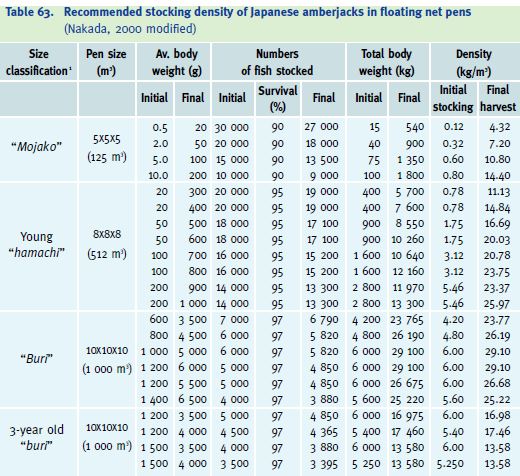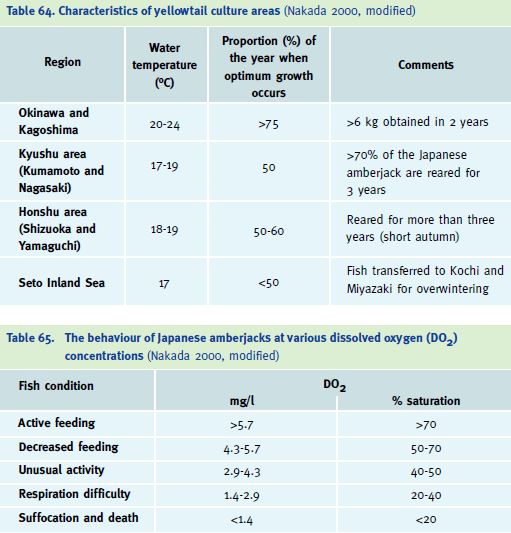Culture systems
Most yellowtail farming is carried out in floating cages. In choosing the location for cage sites, circulation, temperature and pollution must be taken into account. The use of cages, both for rearing and for on-growing purposes, has been the key to the success of yellowtail farming, and is being adopted to a number of other types of fish culture. Floating cages combine the advantages of small and large enclosures (Pillay 1995).
The Japanese techniques for the culture of greater amberjack (S. dumerili), which are called “kampachi”, are the same as those used for Japanese amberjack (S. quinqueradiata) (Harada 1965; Cimmino 1973; Muller-Feuga 1972; Giovanardi 1981; Pena 1981; Nakada and Murai 1991; Grau 1992, Ikenoue and Kakufu 1992). The fry are collected from the wild, and carefully sorted out according to size, in order to prevent cannibalism, a behavioural pattern that becomes apparent after 23 days of life, according to Sakakura and Tsukamoto (1996). Juveniles of 2-10 g are firstly cleaned for parasites by immersion in freshwater. Then they are put in a 2 x 2 x 2 m net cage, with a stocking rate of 1 600–2 000 fish/m3. At 50 g (after 4-6 weeks) the fish are graded again, in order to prevent cannibalism. The on-growing net cages are square or circular, with wood, metal or polyethylene frames.
The sorted fry are reared separately in small floating, fine-mesh net-pens (2-50 m2) which have a depth of 1-3 m (Pillay 1995). The fish grow rapidly. Fingerlings stocked in May/June grow to 200-700 g by August and 600-1 600 g by October; by the end of December they reach a weight of 700-2 000 g.
Japanese amberjack were originally cultured in Japan in ponds, coastal lagoons or lakes, but later, pen culture systems in coastal areas fenced off by nets were used. The development of cage systems started in 1954. Some indication of the number of facilities in 1998 in Japan are given in Table 62.
Table 62. Yellowtail aquaculture facilities in 1998 (M. Mahita, pers. comm. 2002)

Most of present-day production comes from cages (floating or submersible) and some from ponds. Floating cages are used in sheltered sea areas. Harada et al. (1984) stated that net pens were typically 8 x 8 x 8 m, which were less expensive than the previously described systems. This method has the advantages of high water exchange rates, lower maintenance costs, and easier fish harvesting. Cage systems have been adopted by almost all farmers (Nakada 2000). Cage culture does require frequent water changes initially because of bio-fouling that restricts water exchange. The problem was overcome through the use of tri-butyl tin (TBT), which was ultimately banned because of toxicity problems. New chemicals and anti-foulants are now being used.
In Japan, increasingly larger cages have been developed with 15 x 15 x 15 m commonly being used, and the frameworks/collars changing from wood to metal and polyurethane pipes. Even larger cages are being developed - up to 50 x 50 x 50 m. For large fish like Japanese amberjack, sufficient space for exercize is necessary for the development of firm muscle tissue. The recommended densities in floating cages are shown in Table 63. Modifications may be necessary where environmental conditions may cause problems to occur, such as poor flushing rates, shallow water, etc. The use of large cages promotes higher quality meat with correct fat levels that are appreciated by the consumers. In the Republic of Korea, S. quinqueradiata is also cultured in floating cages: juveniles are stocked in floating nylon net cages, ranging from 2 to 50 m2 and 1-3 m in depth. Growing to market size is carried out in cages with an area of 35-100 m2 and a depth of 3-6 m.
Table 63. Recommended stocking density of Japanese amberjacks in floating net pens (Nakada, 2000 modified)

1 These terms are defined in the first paragraph of this chapter.
The performance of marine fish raised in floating cages varies considerably. Exact weights of individual “mojako” are not usually determined before stocking. Records are developed from the total weight of the fish being stocked, which is divided by the estimated total number of fish to determine the average weight. During the culture period, the number of “mojako” in each cage is estimated by subtracting mortalities as they occur. This data is used by farmers to calculate the daily amount of feed (Nakada 2000).
Optimum sites for young Japanese amberjack and greater amberjack culture should have water temperatures higher than 22°C. Nakada (2000) has found that greater amberjack can grow faster and with better feed efficiency than Japanese amberjack if the water temperatures are higher than 17°C. The optimal temperature range is between 24-29°C. Temperatures below 9°C and above 31°C can prove lethal for both species. Water temperatures vary in the areas where Japanese amberjack culture is carried out: so, in each region, farmers have developed specialized ways of rearing that take water temperature fluctuations into account. Table 64 shows
water temperature characteristics for each Japanese region, and the percentage of the year when optimum range/growth occurs. The optimum salinity range for Japanese amberjack is 29.8-36.3‰; the effect of various dissolved oxygen levels is shown in Table 65.
Table 64. Characteristics of yellowtail culture areas (Nakada 2000, modified)
Table 65. The behaviour of Japanese amberjacks at various dissolved oxygen (DO2) concentrations (Nakada 2000, modified)

Since there is no domestic artificially reared seed, S. dumerili juveniles for capture-based aquaculture in Taiwan Province of China are mainly imported from Hanhai Province, southern mainland China. With a maximum size of 1.5-2 m, these fish can grow to 1 kg during the first year in sea cages and reach 5-7 kg after the second year. The major feed used is trash fish; local feed companies are still working on the development of artificial feed to replace trash fish. In 1997, 1.4 million of capture-based fry were transferred from mainland China. The fry (2.5-3.0 cm) price was once high (US$ 1.0-1.5/”seed”) but dropped to US$ 0.4-1.0/fry in 1997. Larger fry
(10-12 cm) cost US$ 2.9-4.5 each (www.aquafind.com/articles/seed.html). In Viet Nam, S. dumerili is cultured on an experimental basis. In Son Tra peninsula, greater amberjack have been cultured in 4.5 m2 square cages, at a density of approximately 5 000 fish/cage (Pillay 1995).
Several studies about the on-growing of S. dumerili, beginning with juveniles (approximately 100 g) captured in the Mediterranean Sea and maintained until they reach a weigh of 1 kg (after approximately one year), have been carried out in Spanish waters (Boix, Fernandez and Macia 1993; Garcia-Gomez and Ortega-Ros 1993; Pastor et al. 2000), in Italian waters (Cavaliere et al. 1989; Lazzari and Barbera 1989b; Giovanardi et al. 1984; Greco et al. 1993; Porrello et al. 1993) and in Croatian waters (Benovic 1980); excellent growth rates have been obtained at all locations. Young fish have been reared in concrete tanks (Cavaliere et al. 1989; Lazzari and Barbera 1989b; Garcia 1993a,b,c; Garcia et al. 1993; Greco et al. 1993) and in net cages (Giovanardi et al. 1984; Navarro, Belmonte and Culmarex S.L. 1987; Grau 1992; Boix, Fernandez and Macia 1993; Porrello et al. 1993). The initial stocking rate for juveniles is 2-3 kg/m3, and the biomass can reach 10 kg/m3 when individual fish are 1 kg in weight (Grau 1992). Greater amberjack has been cultured in sea cages in Spain since 1980, mainly in the Balearic Islands, Murcia and along the Tarragona coast. In the Balearic Islands the fish can reach 1.2 kg after nine months (Grau et al. 1996). Low water temperatures in the Mediterranean Sea during the winter months restricted growth, but when the water temperature reached 20°C in early May and continued above this level until October, growth became extremely fast. The young fish were fed on a diet of trash fish and reached 300-500 g by the end of the first year, and >2 kg by the end of the second. The biomass in the large grow-out cages was maintained at 5 kg/m3. In Italy, both immature and adult specimens are commercially important. They have been the subject of rearing experiments in concrete ponds (Lazzari and Barbera 1989a) and floating cages (Giovanardi et al. 1984; Porrello et al. 1993). Due to its biological features, S. dumerili seems better adapted to rearing in cages than in tanks (Porrello et al. 1993).